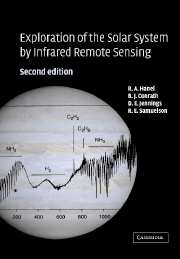Book contents
- Frontmatter
- Contents
- Introduction to first edition
- Introduction to second edition
- 1 Foundation of radiation theory
- 2 Radiative transfer
- 3 Interaction of radiation with matter
- 4 The emerging radiation field
- 5 Instruments to measure the radiation field
- 6 Measured radiation from planetary objects up to Neptune
- 7 Trans-Neptunian objects and asteroids
- 8 Retrieval of physical parameters from measurements
- 9 Interpretation of results
- Closing remarks
- Appendices
- References
- Abbreviations
- Index
6 - Measured radiation from planetary objects up to Neptune
Published online by Cambridge University Press: 07 September 2009
- Frontmatter
- Contents
- Introduction to first edition
- Introduction to second edition
- 1 Foundation of radiation theory
- 2 Radiative transfer
- 3 Interaction of radiation with matter
- 4 The emerging radiation field
- 5 Instruments to measure the radiation field
- 6 Measured radiation from planetary objects up to Neptune
- 7 Trans-Neptunian objects and asteroids
- 8 Retrieval of physical parameters from measurements
- 9 Interpretation of results
- Closing remarks
- Appendices
- References
- Abbreviations
- Index
Summary
In this chapter we provide a partial survey of infrared measurements of a number of objects in our Solar System. In view of the large quantity of available data, we have to be very selective in choosing examples. As in other parts of the book, we give space-borne spectrometry preference over broad-band radiometry. Results from lower resolution data can always be simulated by smoothing higher resolution spectra with a corresponding instrument function. To provide a more balanced view of the potential of infrared techniques we occasionally include examples of spectrometric, polarimetric, and radiometric results obtained from ground-based telescopes in addition to spectrometric data from spacecraft.
In Section 6.1 we show the effects of finite spectral resolution and other instrument characteristics on the recording of the emerging radiation field. Infrared data from the terrestrial planets, that is Venus, Earth, and Mars, are treated in a comparative way in Section 6.2. Emphasis is given to an understanding of the physical principles that cause the structure in the measured spectra. The spectra of the giant planets are discussed in Section 6.3, again in a comparative manner. Section 6.4 is devoted to Titan; as a satellite with a deep atmosphere it is in a class by itself. The last section in this chapter (6.5) is concerned with astronomical bodies without substantial atmospheres. Mercury, the Moon, and Io are most interesting examples of this class of objects. The numerical treatment of information retrieval is postponed until Chapter 8.
- Type
- Chapter
- Information
- Exploration of the Solar System by Infrared Remote Sensing , pp. 301 - 341Publisher: Cambridge University PressPrint publication year: 2003



